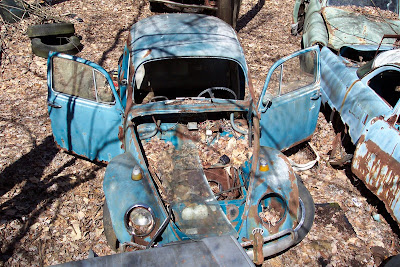
In the Spring of 2003, just days following the US invasion of Iraq, I began the most ambitious project of my career as an artist. I had been exploring self-portraiture as the focus of my gradschool thesis. I was attending the University of Delaware, in a small, conservative city called Newark. My intent was to create self-portraits that metaphorically described not only me, but everyone else as well. My focus was shared attributes that flow across other barriers in human relations. By creating a portrait of the country itself, I would be encompassing all within it. By default, it was a picture of everyone. The scale would have to be colossal. I needed parts.

I asked around a bit, and was given directions to get to a secret junkyard in the Amish countryside of Pennsylvania. I caught a ride with a second-year Gradstudent who had a truck. We drove for miles through nondescript suburbia, then suddenly, a rurality descended.

A few more hills, and some sharp turns down dirt roads, and a forest filled with automobiles appeared.

The brothers who owned the land had grown up there, and their father had lived their with their grandparents. The first cars had been brought in the 1920's, but those were deeply overgrown with forest brush. In not quite a century, the junkyard had expanded to nearly 20 acres, and included all sorts of amazing things. I would comb it for parts.

The junkyard was like Disneyland with no lines. Every car was filled with more, random objects. There was no telling what you might find. The further you went in, the more expansive it became. Cars were stacked on cars, row after row.

On a beautiful fall or spring day, a whole afternoon could pass in a blink.

I collected the parts I needed based on color. My map was simple. I needed Green, Red, Orange, and Yellow. I would also need a fair amount of blue for lakes.

I piled it in one corner of my studio, making a junkyard of my own.

The logical starting point was Texas.

I made the familiar shape about 5 feet square. It would serve as the key for the rest of the project, so it was important to proportion it correctly. Eventually, it would look like this:


The next state would be New Mexico, and the color would be orange.

I used a dented hood from a rusted Ford Pinto.

Together, the two shapes formed a landmass, tiny, but growing.


Some bits of a bicycle and farm machinery began the first yellow state...

...and Oklahoma was born.

More trips to the junkyard followed....



...and the map continued to grow.

As fast as I could gather parts....

...I would use them.

Gradually, the map began form....

...and the junkyard began to shrink.

In time the distinction between it and my studio became smaller and smaller.

To the casual observer, the two were one in the same.

I myself had trouble at times telling the difference.

By this time I needed some context. I laid out a grid on my studio wall to approximate latitude and longitude.

I plodded onwards, working 12 hours a day,

7 days a week.

I chopped things up using a bandsaw or floor shear.

I would draw the shapes on the wall in pencil for reference.

During this time period I had no other obligations besides making art, and I took full advantage of the luxury.

The junk in my studio ebbed and flowed, moving steadily from the floor to the wall.

The junkyard became nearly devoid of color,

and my studio grew bright.


More and more salvage time was spent hunting for new pockets of unexplored terrain.




From time to time I'd discover an amazing sight,



and sometimes I would not.


In my studio, the map began to take on new dimensions.

It became too tall to continue upwards, so I began to work on filling in details.

According to my plan, many levels of information were necessary.

The interstate highways would all be traced with drinking straws, the bendy kind.

Major rivers would be outlined with blue copper wire.

Major cities would be blossoms, resembling lotus flowers,

made from coins, flattened with a metal roller,

and riveted together patiently.

I knew my mission. The rest was simply a matter of keeping a steady pace.

Day after day, more details began to flow.

In time, each state neared completion.

With 52 weeks to work,

and 48 states to make,

I couldn't afford to spend more than 1 week on any one state.

My life in spring 2004 was going to be a blur.



My project blossomed and spread.

I was giving new life to somebody's abandoned friends.

I was turning worthless items into beauty.



Relentlessly I pushed forward.

The clock continued to tick.

I took more trips to the junkyard.

I surged ahead in my studio.


I would spend one day in the East,


and the next in the West.


In time, the entire mass began to fill out.

I studied topography as well as geography, and the hills and valleys are all more or less correct.

The Appalachians are smoothly round, and rise about 24 inches from the wall.

The Rockies are sharp and jagged, sticking out nearly 5 feet.

Sea level is approximately 6 inches.

The cities gleam and beckon.

The interstates radiate between them.

Oklahoma City and Tulsa, followed by Albuquerque.

During the fall semester of 2003, I completed the entire South.

Next I would slide the top row to the bottom and build the North.

The entire sculpture spans a 30 foot wall.
.jpg) Starts at 7pm
Starts at 7pm 



































































































































































